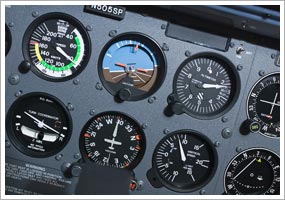CLIMBING, COOLING, CLEARING
 What's the description of a well-executed climb to altitude after takeoff? Setting up the aircraft at the airspeed that delivers the desired rate of climb (Vx or Vy) is the first goal. Trimming the aircraft to maintain the climb airspeed comes next. But is that all there is to it?
What's the description of a well-executed climb to altitude after takeoff? Setting up the aircraft at the airspeed that delivers the desired rate of climb (Vx or Vy) is the first goal. Trimming the aircraft to maintain the climb airspeed comes next. But is that all there is to it?
Not exactly. In a climb to cruise altitude, collision avoidance and the efficient management of your aircraft's engine also demand attention. The designated pilot examiner who will conduct your flight at checkride time will want to see that you have the big picture in mind.
When climbing after takeoff, especially during warm weather, monitor your oil-temperature gauge for any signs of engine overheating. The design of an air-cooled engine (the type installed in most general aviation aircraft) "is less effective during ground operations, takeoffs, go-arounds, and other periods of high-power, low-airspeed operations," explains Chapter 5 of the Pilot's Handbook of Aeronautical Knowledge. The solution: "High engine temperatures can be decreased by increasing the airspeed and/or decreasing the power."
If the pilot's operating handbook for your trainer calls for full-power climbs, lower the nose and climb at a higher airspeed, once safely above obstructions. You should also consider leaning the fuel-air mixture.
Collision risks are elevated during climb because the nose-up climb attitude of the aircraft curtails forward visibility. In an extended climb, lower the nose at regular intervals and scan the airspace ahead. Accompany these clearing maneuvers by performing gentle, coordinated banks left and right so you can scan zones obscured by the wings. Also remember blind spots created by a high glareshield or other aircraft design features, as discussed in the AOPA Air Safety Foundation's Collision Avoidance Safety Advisor.
Clearly, there's more to a good climb than just holding the correct airspeed!
No comments:
Post a Comment